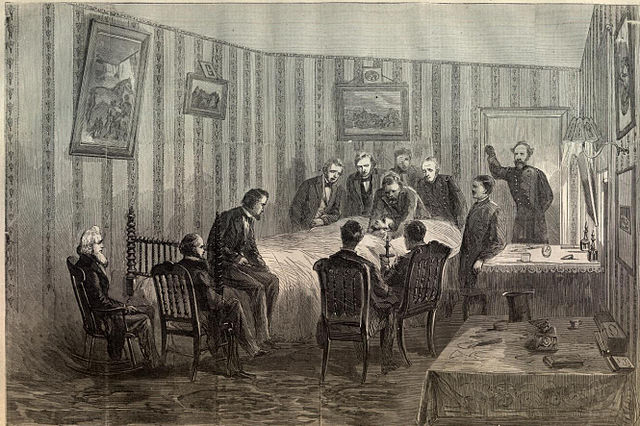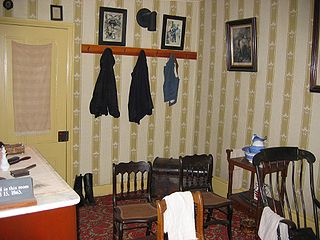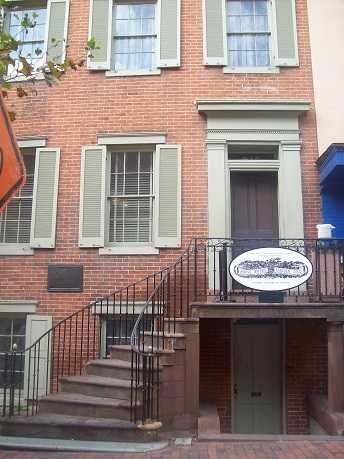The House Where Abraham Lincoln Died

This April marks the 150th anniversary of the assassination of American president Abraham Lincoln. On April 14th 1865, the 56 year old president had been watching a play at Ford’s theatre with his wife when John Wilkes Booth, an actor and Confederate sympathiser, shot him in the head. The president was taken from the theatre to a house across the road where he lay until his death came at 7:22am the next morning.
Those carrying President Lincoln from the theatre were racked by confusion and shock. After all this was the first time an American president was assassinated. The street was starting to get congested with curious onlookers and one such curious onlooker was 25 year old Henry Safford who was renting a room on the second floor of William Petersen’s house. Safford noticed the bewilderment of those carrying the injured president and he called on them to bring him into the safety of Petersen’s house.
17 years previously, a German tailor by the name of William Petersen built the three story townhouse where the president would die. Today it is known as ‘The Petersen House’ and was the home of the Petersen, his wife, and a number of lodgers. When the dying president was carried into the Petersen’s house at 516 10th street on that April night in 1865, their home and life from then would on never be the same.

The severely wounded president was carried up the steps of the red brick house where Safford directed them to a small back bedroom on the ground floor. The bedroom where President Lincoln was brought to was the lodgings of William Clark who was a union soldier and not there on the night. The lanky body of the president was placed diagonally on Clarks small bed. There is an unconfirmed story that John Wilkes Booth had been in the same room and rested on the same bed only months before. The story goes that an actor friend of his was renting the room at the time and Booth had visited him one day to take a rest.
Up to 90 people came and went throughout the long night while Mr and Mrs Petersen along with their lodgers moved themselves to the basement of the house where they spent the night. The superintendent of the police in Washington D.C used the back parlour of the Petersen’s house to interview witnesses. He had also ordered police to stand guard outside the house while soldiers were posted on the rooftop.

While the back parlour was being used to interview witnesses, the front parlour was where Mrs Lincoln was being consoled by members of the White House staff. In the back bedroom the dying president was surrounded by members of his cabinet, army generals and a number of doctors, who were all cramped into the small room.
The president lingered all night until he died the next morning at 7:22am with his son Robert by his side. Also present was the secretary of war Edwin Stanton, senator Charles Sumner and generals Henry Halleck, Richard Oglesby and Montgomery Meigs. Robert Lincoln stood at the head of the bed crying on the shoulder of Senator Sumner and when President Lincoln drew his last breath the Secretary of War Edwin Stanton famously stated: ‘Now he belongs to the ages.’
In the aftermath of President Lincolns death, the house of William Petersen and his wife Anna became an unofficial tourist attraction, much to the annoyance of its inhabitants. People would arrive at the Petersen’s house to see where the president had died and some would even take souvenirs such as pictures from the wall and cuts of carpet from the floor. Such cheek!
Six years after the assassination of President Lincoln, William Petersen died from overdosing on a mixture of alcohol and opium. Police found him unconscious on a bench outside the Smithsonian institute on the Washington mall and brought him to the police station where he passed away. Four months after the death of her husband, the grief-stricken Anna Petersen also died.

After the tragic deaths of the Petersen’s the furniture of their famous house was put up for auction, including the death bed of President Lincoln. Much of the furnishings were bought by collectors including that famous bed which was bought by a collector in Chicago for $80. In 1896 the Petersen house was bought by the United States government for $30,000 and became an historical landmark. Since then the National Parks Services have maintained it as a museum and today the house is furnished in the same way it was on that night in 1865 when America experienced its first presidential assassination.
On a visit to Washington D.C a few years ago, I dropped in to the Petersen house for a nose around. It takes only a few minutes to walk through the narrow dwelling and see the parlour where Mrs Lincoln spent the night grieving as her husband lay dying in the back bedroom only feet away. The bedroom is indeed very small and I could only imagine the lack of space on that night when doctors and white house staff along with family members all clambered about amid chaos and confusion.
Images via wikimedia, except banner (via Garret On The Road) and modern exterior (author’s own photograph).
